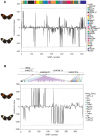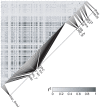Genetic evidence for hybrid trait speciation in heliconius butterflies
- PMID: 20442862
- PMCID: PMC2861694
- DOI: 10.1371/journal.pgen.1000930
Genetic evidence for hybrid trait speciation in heliconius butterflies
Abstract
Homoploid hybrid speciation is the formation of a new hybrid species without change in chromosome number. So far, there has been a lack of direct molecular evidence for hybridization generating novel traits directly involved in animal speciation. Heliconius butterflies exhibit bright aposematic color patterns that also act as cues in assortative mating. Heliconius heurippa has been proposed as a hybrid species, and its color pattern can be recreated by introgression of the H. m. melpomene red band into the genetic background of the yellow banded H. cydno cordula. This hybrid color pattern is also involved in mate choice and leads to reproductive isolation between H. heurippa and its close relatives. Here, we provide molecular evidence for adaptive introgression by sequencing genes across the Heliconius red band locus and comparing them to unlinked wing patterning genes in H. melpomene, H. cydno, and H. heurippa. 670 SNPs distributed among 29 unlinked coding genes (25,847bp) showed H. heurippa was related to H. c. cordula or the three species were intermixed. In contrast, among 344 SNPs distributed among 13 genes in the red band region (18,629bp), most showed H. heurippa related with H. c. cordula, but a block of around 6,5kb located in the 3' of a putative kinesin gene grouped H. heurippa with H. m. melpomene, supporting the hybrid introgression hypothesis. Genealogical reconstruction showed that this introgression occurred after divergence of the parental species, perhaps around 0.43Mya. Expression of the kinesin gene is spatially restricted to the distal region of the forewing, suggesting a mechanism for pattern regulation. This gene therefore constitutes the first molecular evidence for adaptive introgression during hybrid speciation and is the first clear candidate for a Heliconius wing patterning locus.
Conflict of interest statement
The authors have declared that no competing interests exist.
Figures





Similar articles
-
Assortative mating preferences among hybrids offers a route to hybrid speciation.Evolution. 2009 Jun;63(6):1660-5. doi: 10.1111/j.1558-5646.2009.00633.x. Evolution. 2009. PMID: 19492995
-
Hybrid incompatibility is consistent with a hybrid origin of Heliconius heurippa Hewitson from its close relatives, Heliconius cydno Doubleday and Heliconius melpomene Linnaeus.J Evol Biol. 2005 Mar;18(2):247-56. doi: 10.1111/j.1420-9101.2004.00839.x. J Evol Biol. 2005. PMID: 15715831
-
Review. Hybrid trait speciation and Heliconius butterflies.Philos Trans R Soc Lond B Biol Sci. 2008 Sep 27;363(1506):3047-54. doi: 10.1098/rstb.2008.0065. Philos Trans R Soc Lond B Biol Sci. 2008. PMID: 18579480 Free PMC article. Review.
-
Speciation by hybridization in Heliconius butterflies.Nature. 2006 Jun 15;441(7095):868-71. doi: 10.1038/nature04738. Nature. 2006. PMID: 16778888
-
Introgression of wing pattern alleles and speciation via homoploid hybridization in Heliconius butterflies: a review of evidence from the genome.Proc Biol Sci. 2012 Dec 12;280(1752):20122302. doi: 10.1098/rspb.2012.2302. Print 2013 Feb 7. Proc Biol Sci. 2012. PMID: 23235702 Free PMC article. Review.
Cited by
-
Homoploid hybrid origin of Yucca gloriosa: intersectional hybrid speciation in Yucca (Agavoideae, Asparagaceae).Ecol Evol. 2012 Sep;2(9):2213-22. doi: 10.1002/ece3.328. Epub 2012 Aug 1. Ecol Evol. 2012. PMID: 23139880 Free PMC article.
-
Hybridization reveals the evolving genomic architecture of speciation.Cell Rep. 2013 Nov 14;5(3):666-77. doi: 10.1016/j.celrep.2013.09.042. Epub 2013 Oct 31. Cell Rep. 2013. PMID: 24183670 Free PMC article.
-
An evaluation of the hybrid speciation hypothesis for Xiphophorus clemenciae based on whole genome sequences.Evolution. 2013 Apr;67(4):1155-68. doi: 10.1111/evo.12009. Epub 2012 Dec 20. Evolution. 2013. PMID: 23550763 Free PMC article.
-
The functional basis of wing patterning in Heliconius butterflies: the molecules behind mimicry.Genetics. 2015 May;200(1):1-19. doi: 10.1534/genetics.114.172387. Genetics. 2015. PMID: 25953905 Free PMC article. Review.
-
Genetic divergence and the number of hybridizing species affect the path to homoploid hybrid speciation.Proc Natl Acad Sci U S A. 2018 Sep 25;115(39):9761-9766. doi: 10.1073/pnas.1809685115. Epub 2018 Sep 12. Proc Natl Acad Sci U S A. 2018. PMID: 30209213 Free PMC article.
References
-
- Kirkpatrick M, Ravigné M. Speciation by natural and sexual selection: models and experiments. Am Nat. 2002;159:S22–S35. doi: 10.1086/338370. - DOI - PubMed
-
- Coyne JA, Orr HA. Speciation. Sunderland, Mass.: Sinauer Associates; 2004.
-
- Nosil P, Funk DJ, Ortiz-Barrientos D. Divergent selection and heterogeneous genomic divergence. Mol Ecol. 2009;18:375–402. doi: 310.1111/j.1365-1294X.2008.03946.x. - PubMed
-
- Ortiz-Barrientos D, Counterman BA, Noor MA. The genetics of speciation by reinforcement. PLoS Biol. 2004;2:e416. doi: 410.1371/journal.pbio.0020416. - PMC - PubMed
-
- Turner TL, Hahn MW, Nuzhdin SV. Genomic islands of speciation in Anopheles gambiae. PLoS Biol. 2005;3:e285. doi: 210.1371/journal.pbio.0030285. - PMC - PubMed
Publication types
MeSH terms
Grants and funding
LinkOut - more resources
Full Text Sources

